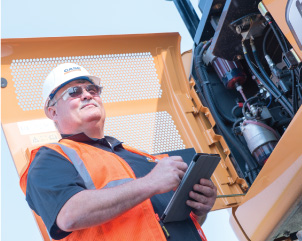Best Practices
Clean Fuel Extends Engine Life
Dirt and dust in your fuel system can reduce engine life by 50%. These contaminants cause more than 85% of all failures in fuel systems.
Even tiny amounts of dirt and dust in your machine's fuel system can become obstructions to the engine's normal processes. Newer engines are even more susceptible to damage, because the fuel injection pressure is higher, and the smallest particles can impair normal engine functions.
Areas of Potential Damage
When dirt and dust are introduced to an area in the engine where quick, sliding movements are important, wear can be accelerated when these small particles interfere with the sliding movement. Examples of these parts are inner and outer valves, nozzle needles and seats, and command piston sliding portions. Two areas where dirt and dust can cause particularly harmful damage are at the interface between the injector barrel and plunger and on the control valves.
Interface between Injector Barrel and Plunger
The amount of fluid required to keep the operation smooth and continuous between the injector barrel and plunger is just 2.5 microns. The introduction of dirt or dust into this area could cause significant interference with this movement.
Control Valves
A decrease in engine power occurs when the control valves, which maintain fuel pressure, begin leaking. Such leaks are caused when contaminants wear away seals.
How to stop dirt and dust from entering the fuel line
Fueling
Properly maintain all fueling equipment. When you refuel, always replace the nozzle back onto the pump, rather than letting it fall on the ground where it could gather dust.
Operation
Construction equipment often operates in a dusty environment. You can prevent dust from entering the fuel system by making sure the vent tube and fuel tank caps are tightly sealed.
Service
While servicing your equipment, minimize the possibility of exposing the engine to the air, which will minimize the risk of introducing dirt and dust into the fuel system. Whenever you change filters, refuel or make any type of engine repairs, accomplish these tasks indoors, if possible, where there is less chance of contamination.
Filters
Change filters promptly at the manufacturer's suggested intervals—clogged filters cannot prevent dirt from circulating through your engine. Use filters that are approved by the equipment manufacturer. Carefully follow the instructions provided in your equipment operator's manual when changing both the main filters and the prefuel filters, so that dust does not enter the fuel system during this process. Always check seals to detect possible leaks.
Tips for Changing Filters
Main Filter
Do not fill the filter element with fuel when changing the main filter to avoid introducing dust during the replacement process. Also, check to insure that the o-ring fits properly. Operate the priming pump to fill the new filter with fuel.
Prefuel Filter
Fill the new filter cartridge for the prefuel filter with fuel before installing it. Check to make sure the cap is attached to the new filter cartridge, then pour fuel into the cartridge (do not use the center hole). Once the cartridge is full of fuel, take off the cap and discard it. Install the prefuel filter cartridge onto the filter holder after applying a thin layer of engine oil to the packing surface of the cartridge. When the packing surface on the cartridge comes in contact with the sealing surface of the filter holder, tighten the filter cartridge to turn.
How to prevent water from entering the fuel line
At night, condensation can occur due to a drop in the temperature while the equipment is not operating, and water may enter the fuel tank. To avoid the formation of condensation, at the end of each day, the tank should be filled up. Before beginning to operate your equipment each day, drain the water and sediment that has accumulated at the bottom of the tank. Similarly, about ten minutes after refueling, water and sediment should be drained from the fuel tank.

